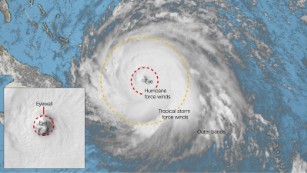Hurricane Isaias heads toward Bahamas and Florida after battering Dominican Republic as a tropical storm
By Jason Hanna, CNN
Updated 2:15 PM ET, Fri July 31, 2020

00:13/02:06
Source: CNN
Hurricane Isaias to impact Bahamas today with long-term plans to hit the US 02:06
(CNN)As a tropical storm, Isaias whipped Haiti and the Dominican Republic and left hundreds of thousands of people without power on Puerto Rico alone.
Now a hurricane, it's heading toward the Bahamas and Florida on Friday afternoon -- and may eventually have much of the US East Coast in its sights.
Isaias strengthened into a Category 1 hurricane late Thursday after crossing the Dominican Republic, and -- with maximum sustained winds of 75 mph -- was hitting the southernmost Bahamas islands with rain and wind Friday morning.
The hurricane is expected to slam the Bahamas and the Turks and Caicos with 4 to 8 inches of rain and leave potentially life-threatening flooding Friday and Saturday, the National Hurricane Center says.
Isaias' center then is expected to get close to Florida's east coast Saturday or Sunday -- a threat that has prompted the state to shut down some testing sites for Covid-19. Rains from outer bands could hit South Florida by Friday night.
South and east-central Florida could see 2 to 4 inches, with isolated totals of 6 inches, from Friday night through Monday, the NHC says.
Much of the Bahamas is under a hurricane warning.
A hurricane watch has been issued for parts of Florida's Atlantic coast -- from north of Deerfield Beach to the Volusia-Brevard County line -- an area including Boca Raton, West Palm Beach, Melbourne and the Space Coast.
An area from north of Ocean Reef to Sebastian Inlet, including Miami, is under a tropical storm warning.
And in coastal North Carolina, where winds of tropical storm force are possible Sunday night, officials have ordered a mandatory evacuation for Ocracoke Island. It starts at noon Friday for visitors and 6 a.m. Saturday for residents.
On Thursday, Isaias' exterior slammed Puerto Rico before it went over the Dominican Republic, all as a tropical storm. It left 300,000 to 400,000 people without power in Puerto Rico, National Weather Service San Juan meteorologist Gabriel Lojero told CNN.
It dropped 5 to 10 inches of rain, triggering flash floods and mudslides on the island, Lojero said. One woman went missing after her car was swept away, he said.
"A lot of neighborhoods were submerged under water," Lojero said.
More rain is expected Friday in the Dominican Republic and Haiti; by storm's end, up to 12 inches of rain could have accumulated in some areas there, the NHC said.

A man guides a tow truck under a downed power line pole after Tropical Storm Isaias affected the area in Mayaguez, Puerto Rico, on Thursday.
A storm threat during a pandemic
Florida closed some state-supported Covid-19 drive-thru and walk-up testing sites on Thursday in anticipation of the storm.
Testing sites would remain open in 11 counties, nearly all of which are on the west coast or the Panhandle, the Florida Division of Emergency Management said.
The division said it anticipates all sites being opened by 8 a.m. August 5 at the latest.
The storm comes at a sensitive time during the coronavirus pandemic. Florida reported nearly 10,000 new Covid-19 cases Thursday, the highest total for one state on that day, according to data from Johns Hopkins University.
Miami-Dade County Mayor Carlos Giménez told CNN on Thursday he would be concerned about keeping evacuees socially distanced if a hurricane hit the state.
"Look, if we have a major hurricane here, then we're going to have to evacuate a number of people and then we're going to have to ... try to keep them separated as much as possible," he said. "That's a concern."
"When you're not testing is also a concern," he added. "But the greater danger, the immediate danger has to be taken care of first, and that's getting our people out of harm's way."

Fire and rescue workers cut the branches of a tree that fell under heavy rain caused by Isaias in Santo Domingo, Dominican Republic, on Thursday.
Exactly where, and how intensely, it will affect the US is uncertain
Where Isaias will affect the US, and how intense it will be, was still uncertain Friday morning.
Some forecast models show the storm slowing down and coming very close to the Florida coast Saturday and Sunday before getting near the Carolinas on Monday and Tuesday. In contrast, others curve the hurricane away from Florida and directly toward the Carolinas.
Either way, the storm could affect much of the US East Coast at some point into next week -- potentially bringing winds of tropical-storm strength as far north as Maine by early Wednesday.
"The details are not very clear at all, especially considering the track uncertainty, but there is a notable chance of a hurricane moving close to the US East Coast, so the forecast continues to show that scenario," the NHC said in a forecast discussion Friday morning.
"Interests along the entire US East Coast should monitor the progress of Isaias and updates to the forecast," the discussion continued.
Isaias -- pronounced (ees-ah-EE-as) -- is the Atlantic's earliest storm on record to begin with an "I." The previous record was set on August 7, 2005, part of the busiest season to date.
This continues the record-breaking pace of the 2020 Atlantic hurricane season. It is the first time on record that the Atlantic basin had two hurricanes -- Isaias and Hurricane Hanna -- form in the last week of July, according to Philip Klotzbach, a Colorado State University research scientist.
CNN's Judson Jones, Sara Tonks, Madeline Holcombe, Dakin Andone, Joe Sutton, Hollie Silverman and Dianne Gallagher contributed to this report.
- PAID CONTENT














No comments:
Post a Comment